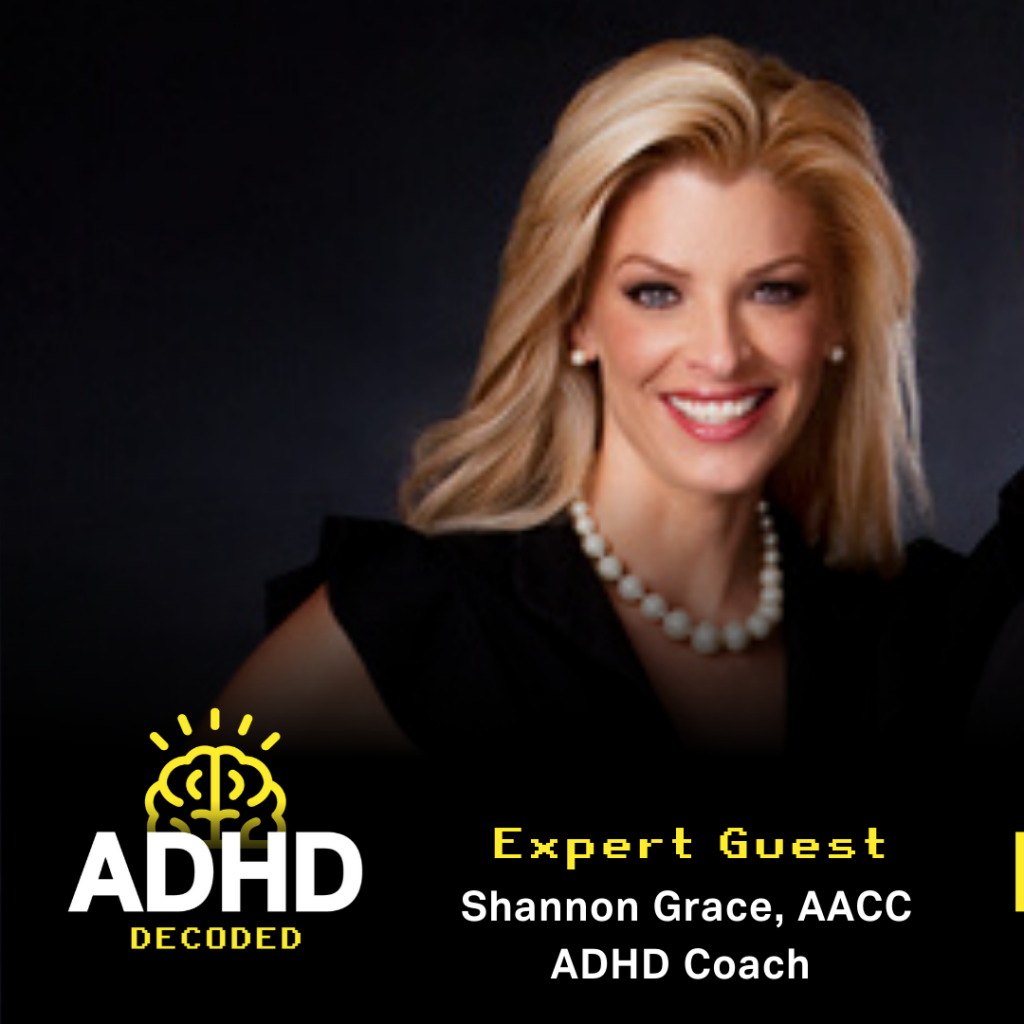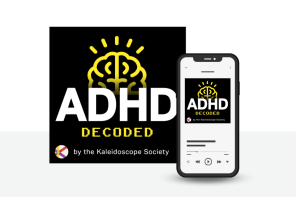Many of us with ADHD have a love-hate relationship with structure and routine. We recognize the value of structure, but we can get easily bored with sameness and find it challenging to stick to routines.
We brought in certified ADHD Coach Shannon Grace Sokol to join us on the ADHD Decoded Podcast to help us decode structure and routine.
Listen to the episode
Other ways to Listen:
Featured Expert: Shannon Grace Sokol AACC

Shannon Grace Sokol is an ADHD Coach passionate about helping women with ADHD come to know their infinite self-worth FROM THE INSIDE OUT & THE OUTSIDE IN. She completed her training with the ADD Coaching Academy (ADDCA) accredited by the International Coach Federation (ICF). As an ADHD’er herself, she is committed to creating an environment for her clients to feel safe and to be understood. You can contact Shannon directly at info@shannongraceconsulting.com to schedule a free ADHD coaching consultation.
Episode Transcript
Amanda:
Welcome to the ADHD Decoded podcast, your roadmap to understanding the ADHD brain. Here, we offer you brain hacks to inspire and empower you to take charge of your life. Whether you are recently diagnosed, have been coping for years, think you might have ADHD, or are wanting to learn more about the ADHD brain in general, then this podcast is for you. I am your host, Amanda Fischer. This is brought to you by the Kaleidoscope Society.
The episode was made possible with the sponsorship support of Shannon Grace Coaching and Consulting. Shannon is an ADHD coach who is passionate about helping women with ADHD come to know their infinite self worth from the inside out and the outside in. She completed her training with the ADHD Coaching Academy, accredited by the International Coach Federation. As an ADHDer herself, she’s committed to creating an environment for her clients to feel safe and to be understood.
In this episode, we’re decoding structure and routine. We need structure to survive, but as ADHDers, we easily get bored with sameness. In this episode, we are going to talk about how to find the balance between structure and stimulation, as well as how to create structure and routine.
I am pleased to introduce to you all our special guest, Shannon Grace Sokol. Hey, Shannon. How’s it going?
Shannon Grace:
Good, Amanda. How are you?
Amanda:
I’m great. Thank you so much for joining us on ADHD Decoded. Before we jump in, what is an ADHD coach?
Shannon Grace:
An ADHD coach helps one define their ADHD abilities in a very confidential, nonjudgmental, safe environment. We help ADHDers find out what they want out of life, what they need. We help them move forward. Coaching works with finding a solution, a path forward towards the client’s future.
Amanda:
It’s so, so very helpful. One of our past guests on the podcast, Dr. Honos-Webb, she says ADHD is an attention deficit, and a lot of times it’s, we need to ask ourselves are we paying attention to what we’re supposed to be doing. I feel like having that ADHD coach is that accountability that one really needs to focus on what we are actually needing to be doing, right?
Shannon Grace:
Absolutely. I’m going to say this too. Everybody’s working on something. Everybody’s working on something, whether you’re an ADHDer or not. I heard someone say that ADHDers, we have to deal with extra coping skills.
They use Stevie Wonder as an example. He’s blind and has had to learn extra skills and strategies to be the most well known artist in the music industry. So we, as ADHDers, all we have to do is learn the extra skills that we need to deal with our life in the matter through an ADHD lens, just as Stevie Wonder has to come up with extra coping skills for blindness. It definitely struck me as, “Oh, okay. So we can do this.”
Amanda:
I really like that analogy that you use with Stevie Wonder, because especially in regards to the topic of this podcast, Structure and Routine Decoded, any average person who doesn’t have ADHD needs structure and routine, but like you said, we need that extra help and those extra skills to learn how to have structure and routine in our lives, just because it doesn’t come to us naturally. That’s just not how our brains are wired. So we need the extra help.
In order to achieve our goals, personally and professionally, we know we need to have structure, routines and habits. How do we build routines and habits to live the life that we want?
Shannon Grace:
First of all, I want to say, there’s hope. There is hope that you can retrain your brain. There is a purpose for our ADHD lives. I want to say that again. There is a purpose for our ADHD lives. This is a disease. It’s in the DSM-IV book. So it does exist. ADHD is defined by the lack of interest.
Neuroplasticity is our hope. Dr. Jeffrey Schwartz is a research psychiatrist at UCLA School of Medicine. He wrote in the International Journal of Coaching Organization, he defined neuroplasticity as being the ability of an individual to alter his or her own brain activity through active practice of focusing attention in constructive ways.
Our choices change our functioning of our brain, which then impacts the way we see the world and interact with it. So hope is found in the retraining of our brain, but yet education is key to overcome our difficulties with regards to structures and routines, and anything else for that matter.
Amanda:
Shannon, what do you think are the challenges around sticking to a routine as ADHDers?
Shannon Grace:
How much time do we have? I think we have to be aware of our thoughts that are stopping us from taking action, what are our belief systems, and knowing how your brain works best, and learning to self regulate and be aware of your distractions in your environment.
One of the things you can do is just put your phone in a different room. That’s so important. I just recently, when I say recently, in the past couple months, tried that, and it does create a different kind of mentality and extra focus for what you’re doing, because you know your phone is in the other room.
I think it’s important that ADHDers write things down, because there’s a saying, as ADHDers, if you don’t write it down, it’s as if you never told us. That can be a major hack of trying to remember all the things that people have told you. So keep a notebook. Walk around with a notebook or Post-it notes.
But education is the most important part. It’s the number one strategy of living well with ADHD. The knowledge that we just talked about will affect your life immediately, wouldn’t you say?
Amanda:
Oh, I would say so, Shannon. I remember … There’s so many times when, for example, my mom or my dad will tell me something important, and I’ll be like, “Look. I need to write that down or else I will not remember to do it. So just give me a second.” I will go get a Post-it note, or I will go get my phone and send an email reminder to myself, because my email’s my to-do list. Sound familiar, Shannon?
Shannon Grace:
Yeah, very familiar.
Amanda:
But hey, these things work. They’re so simple, but we just need those touchable reminders.
Shannon Grace:
Exactly. For you to take that pause to say to Mom and Dad, “Hold on just a second,” for you to be able to recognize, in that moment, what you needed is exactly what us trained coaches do. We teach you the pause, and be aware of what’s coming up in your body.
Shannon Grace:
When you and I were working together, I called it the stop drop and roll theory. In reality, what I was trying to teach was just pause for a minute. What do you need in that second? Stop, drop and roll, and give yourself what you need in that moment.
Shannon Grace:
But as ADHDers, we don’t know what we need. ADHD coaches reflect that and help our clients find out what we need in that moment. It’s so important that if you think you might have ADHD, find a specialist, find a doctor. If you can’t find one, contact me. I will find one for you so you can get the right diagnosis for your brain, because it’s very important. That test will tell you what you need sometimes when you don’t know what you need.
Amanda:
Yeah, absolutely. Shannon, a little bit ago, you mentioned how us ADHDers, we need help identifying when to pause. I think part of that goes with the culture that we live in that’s just go, go, go. Work hard. Play hard. It’s all or nothing. Us ADHDers, we’re already programmed to be all or nothing.
Shannon Grace:
Are you talking about impulsivity?
Amanda:
I think that’s certainly part of it, certainly part of it. But how can we go after our goals, but also take care of our mental health?
Shannon Grace:
I will tell you, this is, I think, a hard one for us. It’s self care. It is having self compassion, and finding out what our brain needs. Our brain needs downtime. Our brains need us to schedule downtime for ourselves, and schedule time to be in an environment that we enjoy, such as something that’s fun, something that’s humorous, to give our brain some downtime to regroup. Self compassion is the most important thing that I think we can do for ourselves. I think we have to give permission to ourselves to create and schedule that self care.
Amanda:
Mm-hmm (affirmative). I remember when I was working with you, Shannon, I was so hyper focused on a particular goal. You had to remind me to schedule fun, because I was just so laser focused on accomplishing that one goal that you were like, “Amanda, what’s one fun thing that you’re doing this week?”
Amanda:
Because I think even, I’m sure some of our listeners are freelancers or entrepreneurs, and they don’t really have that strict, 9:00 to 5:00 or 8:00 to 5:00 work schedule. They’re their own bosses, so they can create the schedule that they want for themselves. Perhaps they are struggling with how to schedule fun too.
Amanda:
For people who don’t have a lot of structure, like those who freelance, or entrepreneurs, or work in a startup environment, or perhaps are stay-at-home parents, what are some strategies and hacks that you would recommend to them in those environments that don’t have as much structure as a typical 9:00 to 5:00 job?
Shannon Grace:
Well, I think it’s important that you create some kind of structure, and metaphors … You know I’m a big metaphor person. I help my stay-at-home moms come up with certain, “Okay, Mondays are many task days. Fridays are finance days.” Find something metaphorically to have some kind of structure that ignites your brain to get things done.
Shannon Grace:
It’s also important that you know when your brain functions best. For example, myself, my brain functions best in the morning versus in the afternoon. So I know to do the hardest things that I need to get done for the day, first thing in the morning.
Shannon Grace:
One of the strategies to having your brain working at your best potential is getting enough rest. It’s so important. I have clients that call this strategy a game changer. The game changer is going to bed and getting up at the same time every day, as much as you possibly can. It’s a game changer.
Amanda:
Yes. I think, like you were saying, having those main anchors in the day, so in order to find that balance between having those anchors, but also allowing for some fun and spontaneity in the day …
Amanda:
I remember last summer, one of my friends was like, “Amanda, you’re someone who really needs structure and routine, and you’re really good at making it happen. You’re also really good at planning for spontaneity.”
Amanda:
I set aside time in my week, three hours on a Friday, just do whatever. When that time comes, that’s when I’ll decide to do whatever fun thing I’m going to do with family or friends. I don’t necessarily know what we’re going to do, but it’s going to be something fun. That’s one little hack I think that some of our listeners can do. Plan for spontaneity. Have time set aside for that fun thing, but don’t necessarily plan it in advance. Just know you’re going to have something to look forward to.
Shannon Grace:
Absolutely. We call that a reward system. That reward system of that downtime of what you created in those three hours possibly motivated you to get everything done and completed beforehand, because you knew you had those three hours of downtime.
Amanda:
Right. Shannon, how do we prevent burnout, and find a balance between going after our goals, and relaxing and enjoying leisure, and creating space for unfocus?
Shannon Grace:
That’s a big question. Less is more. Less is more. Declutter your life. Make small little changes, the simple changes. Most importantly, keep record of gratitude, gratitude for the littlest things. It’s not go big or go home to an ADHDer, because we have a lot of energy vampires, is what I call them, that zap our energy. So it is so important that we make space for downtime, leisure time, self care.
Shannon Grace:
We don’t have to do things in such a big way. Simplicity is calm, is clarity, is confidence. That hyper focus is a great thing, but sometimes it can lead us to burnout. We have to be aware.
Shannon Grace:
Self awareness is the second most important thing to education. Self awareness of our body. Our mental and spiritualness affect one another. Our mental stability affects our health. It can bring on depression, so on and so forth. So less is more as far as leading to burnout, and giving your self a day to not schedule anything. Sunday fun day.
Amanda:
Yeah. I think it’s so hard to go against that mentality of just go, go, go, because it is so dominant in our culture. People … I studied abroad in Spain two years ago. It’s just so different there. People in Europe, I think, work to live, whereas here in America, we live to work, which isn’t always the healthiest way to go about living our lives, because I think we are made for rest.
Amanda:
I think, as ADHDers, we can create our lives in such a way that accommodates for the way our brains are wired. Because the reality is is that it’s not going to look the same. We’re going to do things differently than neurotypical people, people who don’t have mental health challenges like ADHD.
Amanda:
That leads me to my next question, Shannon. What do you think are some good career paths for people with ADHD? I ask this because I have some ADHD friends and family members who need that 9:00 to 5:00 job with structure. Whereas other people prefer to have a job with more flexibility and a little bit more creativity. Based on what you’ve seen, what do you find is helpful for ADHDers with structure and routine, knowing that everyone is different?
Shannon Grace:
You have to love what you do. If you don’t love what you do, you’re not going to have any interest in getting up in the morning, doing your job. It’s a situational variable. What might work for me might not work for you. Also you might change careers at different times in your life. But what I do know is purpose is everything, purpose and interest in what you do.
Amanda:
Mm-hmm (affirmative). I think loving what you do and finding purpose is applicable to everybody, no matter if you have ADHD or not, but I think it’s just all the more important for ADHDers, because they’re really going to hate their life if they don’t like what they do.
Shannon Grace:
Right.
Amanda:
They’re going to really hate their life if they don’t find purpose in what they’re doing.
Shannon Grace:
I think that also drives their structure and routine.
Amanda:
Mm-hmm (affirmative), because we are ultra-sensitive.
Shannon Grace:
Absolutely. When we love what we do, structure and routine don’t look so bad due to ADHD with our executive functioning that is activation, working memory, emotional regulation, self-monitoring, planning and organizing. When you have a support group and support of the family who understands ADHD, I think that is even more imperative for an ADHDer to succeed in life.
Amanda:
You hit the jackpot, Shannon. One thing you said is you mentioned habit scaffolding or habit stacking. In literature, they’re interchangeable terms. Could you explain more about what habit scaffolding or habit stacking is?
Shannon Grace:
Scaffolding, if you … We’re in construction. We have to build a house. You build the house first with boards. That’s called the foundation. You have to have the foundation in order to keep the house standing up, correct?
Amanda:
Mm-hmm (affirmative).
Shannon Grace:
Same thing with ADHDers. You have to build that foundation. That foundation is filling in the gaps. It might be it’s techniques, it’s strategies on how to live with ADHD.
Shannon Grace:
For instance, body doubling. There’s body doubling support groups out there. So there’s a group that’s body doubling, and they all set a goal for an hour that they want to get done, that they’re having a hard time getting done. People hold them accountable. They’re all on Zoom. Within that hour, everybody’s getting what they needed done, because they’re scaffolding as a support group, to hold each other accountable. Because sometimes we have more interest when somebody’s with us.
Amanda:
Absolutely.
Shannon Grace:
Versus being by ourselves.
Amanda:
I think one more thing I just wanted to talk about with you, Shannon, is you mentioned how us ADHDers have to have the same bedtime and the same wake up time every day. What strategies do you have to really stay true to those bookends of the day?
Shannon Grace:
One of the things I do immediately, my alarm goes off and plays upbeat music, and I can’t turn that music off. That’s my boundary, setting boundaries for ourself. I’m not allowed to turn that music off until I’m up out of bed. Then I go right to the shower. The shower actually wakes us up in the morning. Again, we have to have a purpose to get out of bed.
Shannon Grace:
It’s coming up with your own routines and strategies for yourself. They change over time. You’re going to get bored with strategies and routines. We call that looking for ways to resparkle or ignite that routine. You will get tired of your routines. That’s okay. That has nothing to do with your character. It’s just time to resparkle. Do things in a different way.
Amanda:
That’s the best thing I’ve heard all day. Yeah. For all of our listeners, I’m just going to summarize what she said. Y’all got to resparkle your routines, okay? Or maybe a more, for all the men listening, a more masculine way, I don’t know, reshine.
Shannon Grace:
Buff? I don’t know.
Amanda:
Yeah. Buff up your routine.
Shannon Grace:
Yes, buff up your routine. We got to find a new word for the men on your podcast.
Amanda:
Yeah, resparkle, I just, I don’t hear men, “I got to resparkle my …”
Shannon Grace:
No.
Amanda:
Maybe some of them. Maybe it works for some, but yeah, that is such a good hack. I feel like resparkling or buffing is only possible with a coach, someone to hold you accountable, because you can’t do it by yourself. You just can’t. You might tell yourself you can, but you can’t.
Shannon Grace:
Exactly.
Amanda:
It’s just so much easier when you have someone else there to hold their hand and run with you. Anything else you would like to share with our listeners before we close up here?
Shannon Grace:
Don’t do life alone. Find another ADHDer to do life with. If you can’t find somebody, contact me, and I will lead you in the right direction to get you within a community with where you’re at and what you need. Because we have to be here for one another. My life mission is to spread this word of what it truly means to be ADHD. It has nothing to do with one’s intellect or character. We have to stop defining it that way.
Amanda:
Thank you so much, Shannon, for your time and your expertise, and just your witness to living life with ADHD, and not letting it define our amazing capabilities. Thank you so much.
Shannon Grace:
Thank you.
Amanda:
I’m sure it will really help our listeners. Yeah, just can’t thank you enough for all of your, just everything.
Shannon Grace:
Thank you, Amanda. It was a pleasure doing this with you.
Amanda:
Thank you so much, Shannon.
Amanda:
Wow. We have learned so much. A key takeaway is that we can actually retrain our brains through neuroplasticity. In order to create the scaffolding that we need to thrive, we need help creating healthy structure and routine.
Amanda:
First, a great place to start is having good bookends to your day. It is much easier said than done, and it is still so important. Go to bed and get up at the same time every day as much as you possibly can. Have a morning and night ritual to signal to your brain that it is time to either wind down and turn off or wake up and start fresh. For example, every night before I go to bed, I do twinkly lights and tea, and read my book, and that’s it. Keep it simple.
Amanda:
Second, use creative theme days to signal to your brain what day it is, like many task Mondays, finance Fridays, or Sunday fun day, which will ignite your brain to give you structure and get things done. I’m thinking about doing many tasks Mondays.
Amanda:
Third and finally, resparkle or buff up your routines when they get old or boring.
Amanda:
Thank you for tuning into ADHD Decoded, a podcast by the Kaleidoscope Society. This is your host, Amanda Fischer. Until next time, be the boss of your brain.




